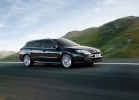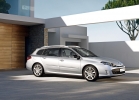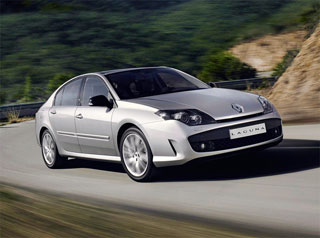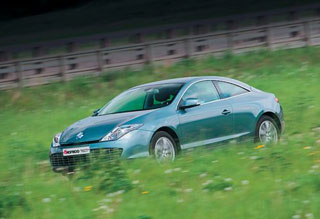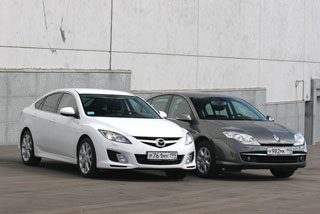Renault Laguna test drive since 2007 hatchback
With an aim to leadership
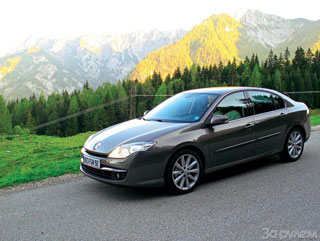 The third generation of Renault Lagun, as expected, is more, more comfortable and more expensive than its predecessor. The car was mastered by Anatoly Fomin. Photo by the author and Renault.
The third generation of Renault Lagun, as expected, is more, more comfortable and more expensive than its predecessor. The car was mastered by Anatoly Fomin. Photo by the author and Renault. Sales in the D segment in Europe have been falling for several years in a row. Over the past decade, its share has declined from 22 to 15% of the market. Last year, large sedans, station wagons and hatchbacks bought more than 3.5% less than in the year before last. Buyers, as if conspiring, are transplanted into more compact cars. Ecological consciousness or requirements of close cities? Alas, the income of many Europeans simply does not keep up with the growth of cars for cars. However, the leading manufacturers of business class cars are growing. So, you can fight for the market!
Pleasure with comfort
The lagoon has grown noticeably. But even increasing 90 mm in length, 35 mm in width and 10 mm in height, this Renault is still noticeably less than classmates. I am glad that the designers did not go to the temptation to inflate the dimensions for the sake of a more spacious salon and trunk. After all, a gasoline lagoon lost 15 kg, and with a diesel engine to all 65! Thanks to the modest transverse dimensions, the work of CC (0.293) on Midel was also able to keep at 0.645 m2 a good result. After all, excellent aerodynamics are not only a high maximum speed, but also a small fuel consumption at high speeds, a minimum noise level. By the way, a fair amount of aerodynamic perfection in invisible to the engineering space and under the bottom of the car. In the lagoon, it was completely closed by streamlined panels.
 But there are no miracles in the layout. At the wheel of the most expensive lagoon, where leather seats with an electric regulatory are combined with a hatch in the roof, a high driver will rest his head into the ceiling. Those who are higher than 180 cm will have to sit on the floor then with the rear passengers have nowhere to advance their feet. Poking the back of the roof of the hatchback also steals a place, and so that the heads of the passengers do not hurt it, the compotors lowered the seat pillow. The back became spacious, but inconveniently bent legs quickly flow. You could forgive the compact car, but the German classmates of the lagons have already outlived such flaws.
But there are no miracles in the layout. At the wheel of the most expensive lagoon, where leather seats with an electric regulatory are combined with a hatch in the roof, a high driver will rest his head into the ceiling. Those who are higher than 180 cm will have to sit on the floor then with the rear passengers have nowhere to advance their feet. Poking the back of the roof of the hatchback also steals a place, and so that the heads of the passengers do not hurt it, the compotors lowered the seat pillow. The back became spacious, but inconveniently bent legs quickly flow. You could forgive the compact car, but the German classmates of the lagons have already outlived such flaws. However, the comments from the passenger of a modest complexion are not so significant. The lack of space Renault successfully compensates for the excellent quality of the assembly and materials, not inferior to German analogues in this. There are also obvious finds of the original climate remote control, successfully located between the central deflectors, as well as the joystick of control of the multimedia system and navigation. That's really an intuitive menu.
Saving with the calculation
The main motor for the lagoon is a two -liter diesel in three power options: 130, 150 and 175 hp. Middle can be bought with an automatic gearbox. A six -speed hydromechanical automatic machine perfectly hides the Achilles heel of modern diesel traction at low speeds. Six steps with quick switching allow almost nothing to lose in dynamics, however, by the cost of increasing fuel consumption by about 14%. However, with the mechanics, a 150-horsepower turbodiesel is good. It wakes up early and is able to carry from 1,500 rpm, but it supports a peppy good acceleration and at 4000. With intense overtaking, it can be rotated as much as 5200 rpm. There are no problems with the clarity of the transmission. But with the choice ... Given the mountainous terrain, it is not always easy to determine the transmission. The assistant tells the hint in the window of the dashboard, but with its logic I do not always agree. In my opinion, it does not allow to fully use the potential of the motor at low speeds: apparently, insured from a lack of traction?
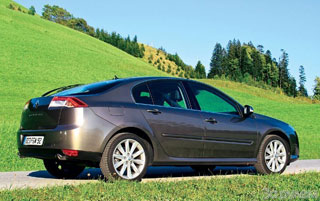 In Russia, gasoline lagons will be sold first of all. Theoretically, the greatest chances of a car with a two -liter engine with a turbocharged and automatic transmission. By current standards, 170 hp Not many at all, but for a torque, the engine may well be compared with a 3-liter atmospheric. A 2 liter motor can be promoted to 6200 rpm. However, there is no need to traction and does not suffer at all from the delay in the turbocharger. It turns out that not only engines with direct injection of gasoline are capable of this! If it would be more transmitting shorter but then it will be difficult to meet 9 l/100 km.
In Russia, gasoline lagons will be sold first of all. Theoretically, the greatest chances of a car with a two -liter engine with a turbocharged and automatic transmission. By current standards, 170 hp Not many at all, but for a torque, the engine may well be compared with a 3-liter atmospheric. A 2 liter motor can be promoted to 6200 rpm. However, there is no need to traction and does not suffer at all from the delay in the turbocharger. It turns out that not only engines with direct injection of gasoline are capable of this! If it would be more transmitting shorter but then it will be difficult to meet 9 l/100 km. In the range there is also a hopeless 2-liter motor, which is offered only with a pen. This configuration also has a chance at a reasonable price. The budget version of the lagoon with a gasoline engine 1.6 could not be tried, and it is unlikely that it will be interested in many. A similar engine often loses to the big even in economy.
A miniature 1.5-liter diesel left a double impression. On the same test route, it turned out to be more economically 2-liter by only 0.3 liters. The working range is already noticeable, you have to switch much more often. Of course, in deaf city traffic jams, he would show the best result, but the mountain roads are clearly not his element ...
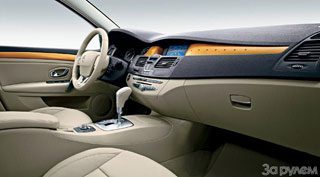 Interestingly, in the rear suspension, the lagoon is not a cunning multi -link design, but an elastic transverse beam. It would seem that today in this class to offer such a scheme is the same as appearing in the Kirza boots in the opera. However, the car goes with dignity, its behavior in turns is almost better than other multi -link rivals. And with the shoes, the lagoon is also all right. At least 16-inch wheels, and on test machines 17- and 18-inch. Despite the simple suspension and mighty reptile stability stabilizers (according to specialists, the angle of roll during a side acceleration of 5 m/s2 is only 1.9 degrees), the lagoon remains obedient even in conditions close to the ultimate clutch. The stiffness of the springs that grew by 20% and 50% (!) Nevertheless, nevertheless, did not make it like a sports car, the stiffness of the move was saved. With such a chassis, not too fast the steering wheel with an electro -hydraulic amplifier is well combined, and to moderately a hard brake pedal allows you to perfectly dose slowdown.
Interestingly, in the rear suspension, the lagoon is not a cunning multi -link design, but an elastic transverse beam. It would seem that today in this class to offer such a scheme is the same as appearing in the Kirza boots in the opera. However, the car goes with dignity, its behavior in turns is almost better than other multi -link rivals. And with the shoes, the lagoon is also all right. At least 16-inch wheels, and on test machines 17- and 18-inch. Despite the simple suspension and mighty reptile stability stabilizers (according to specialists, the angle of roll during a side acceleration of 5 m/s2 is only 1.9 degrees), the lagoon remains obedient even in conditions close to the ultimate clutch. The stiffness of the springs that grew by 20% and 50% (!) Nevertheless, nevertheless, did not make it like a sports car, the stiffness of the move was saved. With such a chassis, not too fast the steering wheel with an electro -hydraulic amplifier is well combined, and to moderately a hard brake pedal allows you to perfectly dose slowdown. Being next to Salzburg and not to listen to Mozart's music is like visiting Paris without seeing the Louvre and the Eiffel Tower. Is the lagoon suitable for enjoying the classic? Quite. Both in terms of the quality of the audio system, and in terms of noise.
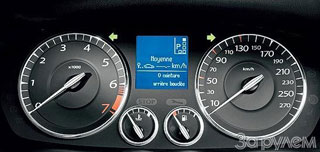 Less commonly and cheaper
Less commonly and cheaper Talk about the reliability of the car, having drove on it a hundred or two kilometers, at least frivolously. But about maintenance, you can. Lagunes with diesel engines and a two -liter gasoline engine are invited to the service once a year or after 30 thousand km. The chain drive of the camshafts allows you to forget about the replacement of the gear belt. However, the gasoline engine with a turbocharged, although it does not require replacing the timing belt to 120 thousand km, but reduces the interval between that to 20 thousand km.
The ecology of 85% of the car parts is not forgotten and 95% of disposal are subject to secondary processing. More than 90 components are made from secondary raw materials, at least 50 kg in each machine!
The start of sales of the third lagoon in Russia is scheduled for spring. If the manufacturer does not overdue with the price, then another interesting offer will be added to the D-class. Renault, by the way, claims to be in the top three leaders both in relation to the quality of cars and their maintenance. A commendable desire ...
Renault Laguna is probably the best French car in the classroom. But in Russia, trust in German and Japanese brands is more, but the car will not get into the budget segment. This is a lagoon, not Logan!
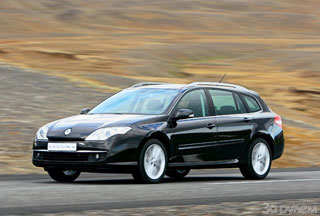
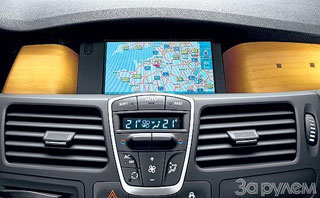
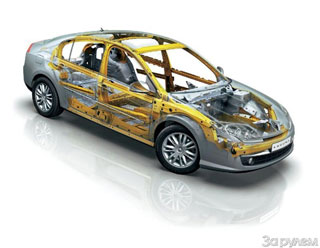

Source: The magazine "Driving"
Video Test Drive Renault Laguna since 2007
Renault Laguna crash tests since 2007
Test drive by Renault Laguna since 2007
Renault Laguna Crash Test since 2007
Krassh Test: Detailed Information36%
Driver and passengers
10%
Pedestrians
41%
Children-passengers




